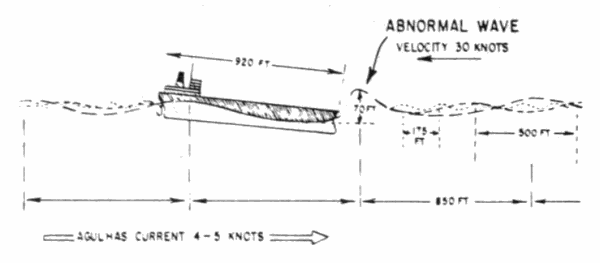 |
Science Frontiers ONLINE No. 137: SEP-OCT 2001 |
|
|
The Ship-swallowers
Suddenly. a ship will find itself in a deep trough. Then conies a wall of water. 50-100 feet high. (34 meters is the biggest reliable measurement.) The vessel is flooded, perhaps its back is broken. It sinks like a rock without even sending a distress signal. Another ship has been devoured by a rogue wave.
 Giant solitary waves are usually preceded by deep troughs. as seen in this sketch of a vessel in the notorious A gulhas Current off the coast of South Africa. (From: Earthquakes. Tides....) |
Just between 1969 and 1994. 60 supercarriers were lost due to sudden flooding. Of this number, 22 were apparently swallowed by rogue waves. The rogue waves appear unexpectedly. They dwarf all surrounding waves. For a long time, the rogues were said to be just chance additions of two smaller waves. But they are too big and occur too frequently to be statistical flukes. In addition, statiticians have trouble in accounting for the fabled and feared "three sisters" -- three massive waves in succession.
Consequently, scientists have retreated to a now-familiar refuge: nonlinear effects. They show mathematically how small perturbations in a physical system can lead to huge consequences -- on paper at least..
(Lawton, Graham; "Monsters of the Deep," New Scientist, p. 28, June 30, 2001.)
Comments. Somehow, as insinuated above, blaming monstrous waves on non-linear effects is not very satisfying in our cause-and-effect world.
Twenty-two huge vessels swallowed up by giant waves! Yet, we never see notices of such events in the papers! A small tanker oil spill gets much more media attention.
Other Sites of Interest
|